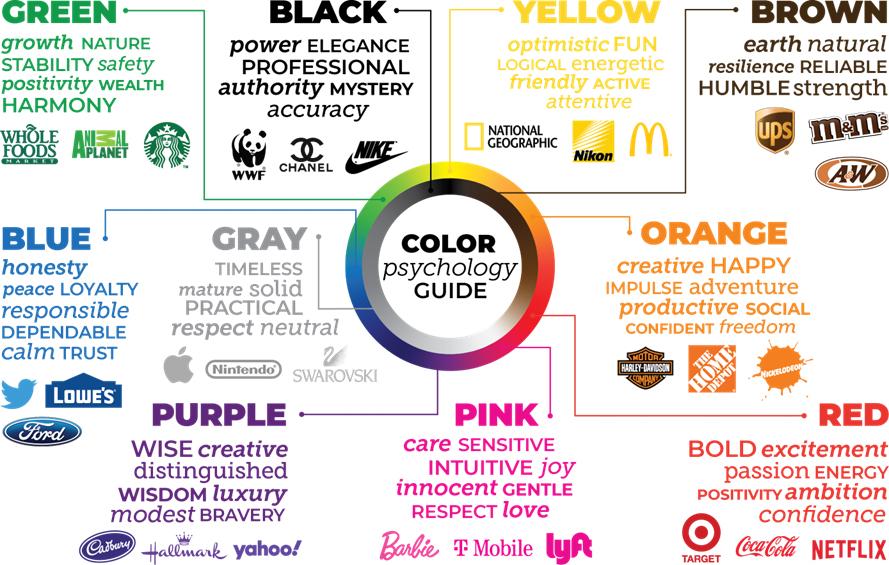
Have you ever stopped to think about why the McDonald’s logo is red and yellow, or why Facebook chose blue for their branding? Well, prepare to have your mind blown as we delve into the wildly entertaining world of the psychological power of colors in logos. From the subtle manipulation of your emotions to the strategic positioning of your wallet, get ready to see your favorite brands in a whole new light – literally! So grab your color wheel and dive into this rainbow-hued journey with us.
The Psychology Behind Color Choice in Logos
When it comes to choosing the colors for your logo, it’s not just about aesthetics – there’s psychology behind it! Different colors can evoke different emotions and associations, so it’s important to choose wisely. Here’s a breakdown of some common color choices and what they might say about your brand:
- Red: This color is often associated with passion, energy, and excitement. It can also stimulate appetite, which is why so many food and beverage brands use it in their logos. So if you want to convey a sense of urgency or intensity, red might be the way to go.
- Blue: Blue is often seen as a calming and trustworthy color. It’s commonly used by tech companies to convey a sense of reliability and professionalism. If you want your brand to be seen as dependable and secure, blue might be the perfect choice for your logo.
- Yellow: Yellow is a bright and cheerful color, often associated with optimism and creativity. It can also grab attention and stand out from the crowd. If you want your brand to exude positivity and energy, yellow could be the way to go.
Remember, the key is to choose a color scheme that aligns with your brand’s personality and the message you want to convey. So next time you’re designing a logo, take a moment to consider the psychology behind the colors you choose – it could make all the difference!
How Colors Influence Consumer Perception
Ever wondered why you suddenly feel hungry when you see a red and yellow logo? Or why certain websites make you feel calm and relaxed with their use of blue and green? It’s no magic trick - it’s the power of colors influencing your consumer perception!
Red: Not only does red make you hungry (thanks, McDonald’s), but it also creates a sense of urgency and excitement. No wonder it’s the go-to color for clearance sales and limited-time offers!
Blue: Ah, the color of trust and reliability. Companies like Facebook and PayPal use blue to establish themselves as trustworthy sources. But be careful – too much blue can also come off as cold and uninviting.
Green: Who knew a color could represent both wealth and health? Green is associated with growth, freshness, and eco-friendliness. It’s no wonder why organic and eco-friendly brands go green with their branding!

The Subconscious Impact of Color on Brand Logo Recognition
Have you ever found yourself automatically drawn to a certain brand just because of the color of their logo? Well, you’re not alone! is a real phenomenon that can greatly influence consumer behavior.
Colors have the power to evoke certain emotions and feelings in people, whether they realize it or not. When it comes to branding, this can be a powerful tool for companies to utilize. Just think about it – how many times have you seen a red and white logo and immediately associated it with a fast-food chain? Or a green and white logo and automatically thought of a well-known coffee company? It’s all about the power of color psychology!
So, what do these colors even mean? Let’s break it down:
- Red: Often associated with passion, energy, and excitement. Perfect for brands looking to make a bold statement.
- Blue: The color of trust, dependability, and professionalism. No wonder so many tech companies use it in their logos!
- Yellow: Represents happiness, optimism, and warmth. Ideal for brands looking to create a sense of positivity.
- Green: Symbolizes growth, harmony, and nature. Great for brands promoting health or sustainability.

Color Associations and Their Effect on Logo Design
When it comes to logo design, the colors you choose can have a big impact on how your brand is perceived. Different colors evoke different emotions and can send different messages to your audience. Here are some common color associations and how they can affect your logo design:
- Red: Red is often associated with passion, energy, and excitement. It can grab attention and create a sense of urgency. However, it can also be seen as aggressive or intense, so use it sparingly in your logo design.
- Blue: Blue is often associated with trust, reliability, and calmness. It can create a sense of security and professionalism. Many financial institutions and tech companies use blue in their logos for this reason.
- Yellow: Yellow is often associated with happiness, optimism, and creativity. It can grab attention and evoke a sense of playfulness. However, too much yellow can be overwhelming, so use it strategically in your logo design.
Remember, the colors you choose for your logo should align with your brand’s message and target audience. Think about how you want your customers to feel when they see your logo and choose colors that will help create that emotional response. Play around with different color combinations and see which ones resonate the most with your brand identity.

Creating Emotional Connections Through Color in Logos
Have you ever noticed how certain colors in logos make you feel a certain way? It’s no coincidence – companies strategically use color to create strong emotional connections with their audience. Let’s dive into the psychology of color in logo design and how you can use it to your advantage.
First off, let’s talk about red. Red is a bold and passionate color that often conveys excitement and energy. It’s no wonder why fast-food chains like McDonald’s and Wendy’s use red in their logos – they want you to feel hungry and ready to eat the minute you see it! So next time you’re feeling low on energy, look for a logo with red – it might just give you the boost you need.
On the flip side, we have blue. Blue is a calming and trustworthy color that is often used by banks and technology companies to convey security and reliability. Think about it – when was the last time you saw a bank logo that wasn’t blue? Blue puts our minds at ease and helps us trust the brand, so next time you need to make a big financial decision, look for a logo with blue to give you that extra sense of security.
And let’s not forget about green. Green is a color associated with nature, growth, and health. That’s why you’ll often see green in logos for eco-friendly companies or health-conscious brands. So next time you’re feeling overwhelmed and need a little zen in your life, look for a logo with green - it might just give you the peace of mind you’re looking for.
The Role of Color Theory in Logo Creation
Color theory is a crucial aspect of logo creation, and not just because it makes your logo look pretty (although that’s definitely a bonus). The colors you choose can have a huge impact on how your logo is perceived, so it’s important to choose wisely. Here are a few ways that color theory can make or break your logo:
- Emotional Impact: Different colors evoke different emotions, so it’s important to consider how you want your audience to feel when they see your logo. Want to convey trustworthiness? Go for blues or greens. Want to grab attention? Opt for bold reds or yellows.
- Brand Identity: The colors you choose can help define your brand’s identity and make it easier for customers to remember you. Think about it – when you see a big yellow M, what do you think of? Exactly. Golden arches.
- Color Combinations: Certain color combinations work well together, while others can clash and make your logo hard to look at. Use color theory to create harmonious combinations that will make your logo stand out for all the right reasons.
So next time you’re creating a logo, don’t just pick your favorite colors and call it a day. Take some time to consider and make sure your logo is sending the right message to your audience. After all, you don’t want your logo to be a rainbow-colored disaster that no one can look at without feeling personally attacked. Trust me, I’ve seen it happen.
FAQs
Why do some companies choose red logos?
Well, red is the color of passion, excitement, and urgency. So, companies looking to evoke strong emotions or create a sense of urgency might opt for a red logo.
What is the significance of blue logos?
Blue is often associated with trust, security, and professionalism. That’s why many financial institutions and tech companies choose blue logos to instill confidence in their customers.
Why are so many fast food chains’ logos yellow and red?
Yellow and red are known to stimulate appetite and create a sense of urgency. That’s why fast food chains use these colors to make you crave their burgers and fries ASAP!
How do green logos impact consumers?
Green is often associated with nature, health, and growth. Companies in the health and wellness industry often choose green logos to convey a sense of freshness and vitality.
What emotions do black and white logos evoke?
Black and white logos are classic and timeless. Black is often associated with luxury and sophistication, while white symbolizes purity and simplicity.
Color Your Logo World with Psychology!
So there you have it – the fascinating world of colors and their psychological power in logos. Next time you see a logo, take a moment to think about the colors used and what message they might be sending. Remember, it’s not just a logo, it’s a whole psychological journey! Keep colorful and keep branding!












